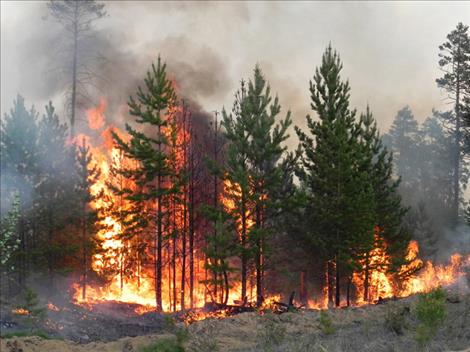Make fire plans during Wildfire Awareness Month
Take action this month to prepare your home, family for wildfire
Hey savvy news reader! Thanks for choosing local.
You are now reading
1 of 3 free articles.
News from DNRC
Now is the time to prepare your home and property for the upcoming wildfire season.
In recent years, wildfire seasons have become longer with larger fires that burn more acres. These wildfires can destroy homes, impact businesses, and threaten lives. Governor Greg Gianforte designated May as Wildfire Awareness Month to increase prevention efforts that reduce the number of human-caused fires, advocate for fire preparedness, and encourage Montanans to foster more fire-adapted communities across Montana.
Be Prepared
Studies show that as many as 80% of the homes lost to wildland fire could have been saved if their owners had followed a few simple fire-safe practices. Getting your home prepared for wildfire can be done with a few simple steps.
Removing fuel from your home’s ignition zone and performing simple maintenance tasks can greatly improve the chances of your home surviving a wildfire. The home ignition zone is made up of three major sections:
Immediate (0-5 feet around the home)
Cover all vents with 1/8-in mesh screening
Fill any gaps in your home’s siding and trim materials with quality caulk.
Fill any openings between the roof covering and the roof deck with a nonflammable material.
Use only nonflammable fencing materials in this zone.
Create a 3- to 5-foot clean and non-combustible perimeter using concrete or rock mulch.
Remove all vegetation in this zone.
Remove tree limbs that extend into this zone.
Relocate all combustible materials, including garbage, lumber, and lawn/patio accessories, to outside this zone.
Clean all fallen leaves and needles from this zone - don’t forget about your gutters and roof valleys.
Locate propane tanks at least 30 feet from any structures.
Intermediate (5-30 feet)
Remove all dead grasses, weeds, plants, and foliage.
Keep lawns and native grasses mowed an water all vegetation regularly.
Grow non-woody, low height, herbaceous plants.
Provide at least 18 feet of space between remaining shrubs and trees. Increase spacing on steep slopes.
Store firewood or other combustible materials at least 30 feet away from your home.
Remove limbs 6’ to 10’ from the ground.
Remove branches that overhang or touch the roof, making sure there is at least 10ft between the structure and the nearest branch.
Clear vegetation around fences, sheds, outdoor furniture, and play structures.
Create fuel breaks with non-flammable walkways, paths, and driveways. Extended (30-100 feet)
Thin trees to a minimum of 12 feet between tops of trees to break up continuous fuels.
Remove small conifers growing between mature trees to create a separation between ground vegetation and mature trees.
Remove leaf and needle debris from your yard.
Keep grasses and wildflowers under 8” in height.
Clear vegetation from under large stationary propane tanks.
Remove vegetation adjacent to storage sheds or other outbuildings.
Maintain space clear of vegetation on either side of your driveway and access roads so that emergency vehicles can reach your home.
Learn how to protect each of your home’s ignition zones to be prepared for a wildfire.
















